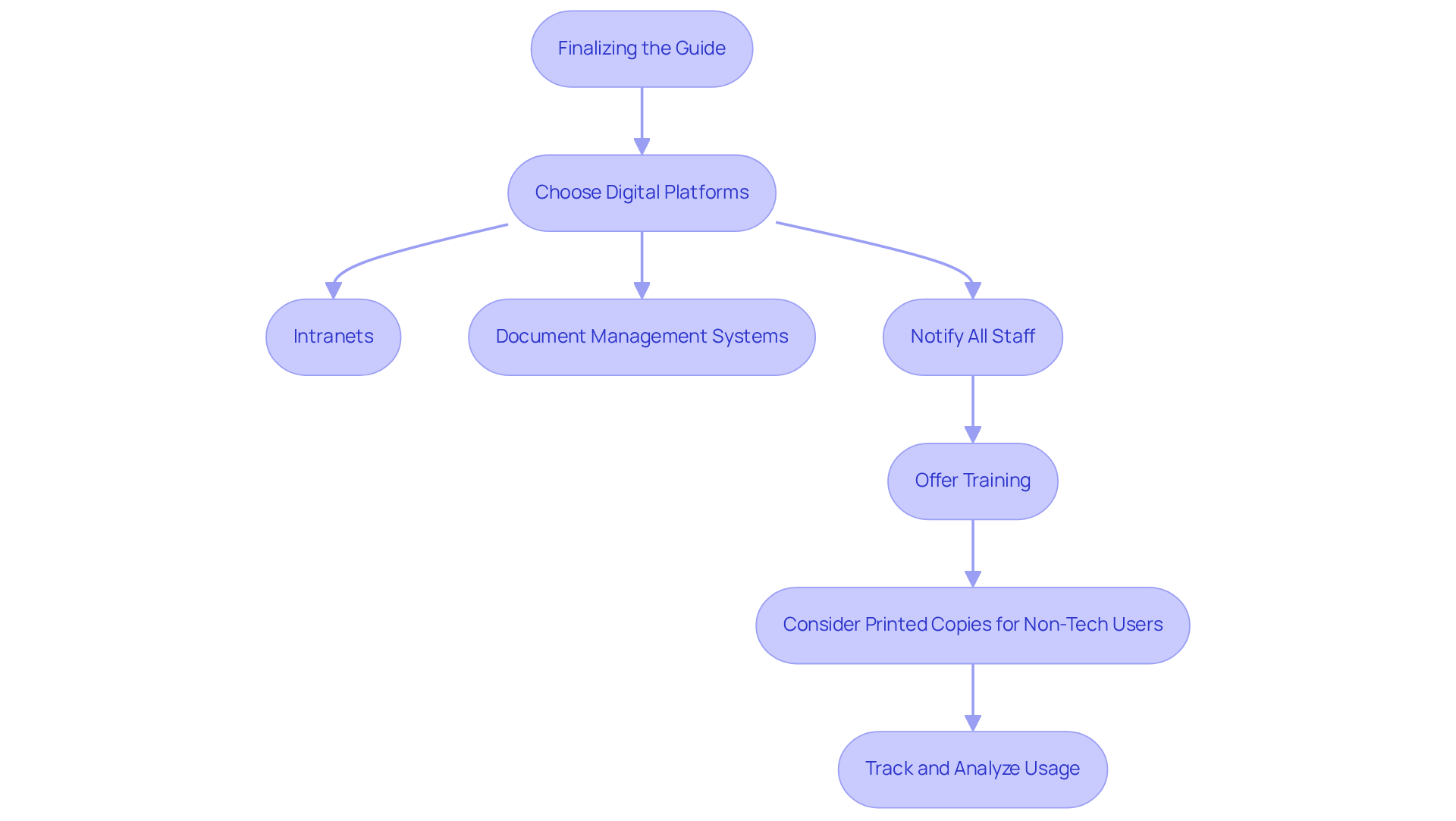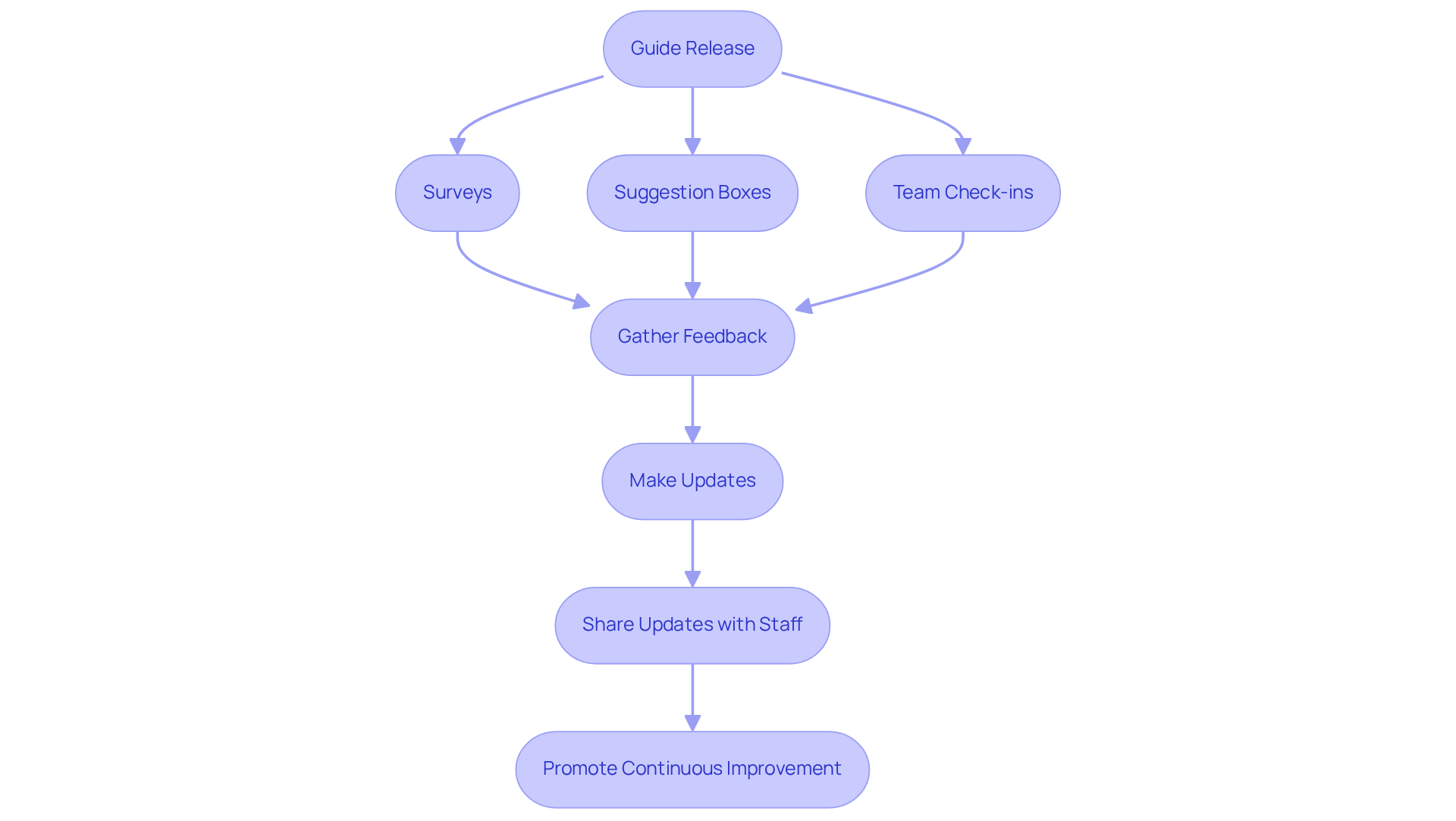
Remote Team Documentation Strategies
|
November 13, 2025
|
7 Steps to Create a Policy and Procedure Manual Effectively
Key Highlights:
- Define the manual's purpose to clarify its importance and guide its development.
- Identify specific problems the manual aims to resolve and its primary users.
- Plan and organise the manual structure with clear sections and a logical flow.
- Utilise bullet points and a table of contents to enhance readability and navigation.
- Involve key stakeholders in the development process to gather valuable feedback.
- Encourage feedback on drafts to ensure the manual meets user needs.
- Write in plain language, avoiding jargon to enhance clarity and accessibility.
- Use headings, bullet points, and examples to break down complex information.
- Establish a review process for regular updates to maintain accuracy and relevance.
- Publish the manual on accessible digital platforms and notify staff of its availability.
- Collect ongoing feedback from users to promote continuous improvement.
- Share updates transparently to keep staff engaged and informed.
Introduction
Creating a policy and procedure manual is a crucial step for any organization looking to streamline operations and ensure compliance. You might be wondering how to go about it, right? This guide offers a structured approach to developing a manual that not only clarifies roles and responsibilities but also boosts operational efficiency.
But here’s the kicker: many organizations struggle with effectively implementing these manuals. Often, employees are left scratching their heads about their purpose and how to use them. So, how can businesses make sure their policy manuals aren’t just gathering dust on a shelf, but instead become dynamic tools that foster clarity and engagement among teams? Let’s dive into that!
Define the Purpose of a Policy and Procedure Manual
You might be wondering how to create a policy and procedure manual effectively. Well, the first step is to clearly define its purpose. This purpose could include objectives like ensuring compliance with regulations, standardizing operations, or simply providing essential guidance for employees. By recording the purpose, you not only clarify the guide's importance but also help everyone involved understand how it will be used within the company.
Consider this: What specific problems does this guide aim to resolve? Who will be the primary users, and what benefits will they get from it? This clarity is super important! Did you know that 38% of organizations feel they’re only doing a fair or poor job at giving employees the tools to find policies? That really highlights the need for well-defined objectives.
So, by establishing a clear purpose, you can steer the development process effectively. This way, the documentation meets its intended goals and boosts compliance efforts. As Friedrich Nietzsche once said, those who pursue clarity are more likely to reach their goals. That’s why it’s crucial to express the guide's purposes right from the start. Effective guidelines and procedures show that when objectives are clear, teams understand and execute them better.
Now, let’s dive into how to create a policy and procedure manual to make this happen!

Plan and Organize Your Manual Structure
You might be wondering how to create a policy and procedure manual that is effective. Well, it all starts with a solid plan for how to create a policy and procedure manual. Think about outlining the main sections—like Introduction, Policies, Procedures, and Appendices—as part of how to create a policy and procedure manual. Each section should have a clear title and flow logically. For example, organizing policies by department or function, followed by their corresponding procedures, can really boost clarity.
Using bullet points or numbered lists? That’s a great way to make things easier to read! And don’t forget about including a table of contents. It’s essential for helping folks navigate the manual quickly, so they can find what they need without a hassle. This organized approach not only simplifies access to important info but also illustrates how to create a policy and procedure manual that reduces the time staff spend searching for documents—averaging about 1.8 hours a day, which is nearly 25% of their workday!
Now, let’s dive into how SowFlow's command-based method can help. With it, organizations can easily develop and tweak their guides, keeping all information relevant and accessible while steering clear of unnecessary meetings. As Masaaki Imai wisely said, "It is impossible to improve any process until it is standardized." By using a well-structured guide with SowFlow's tools, companies can boost operational efficiency and empower their staff to handle their responsibilities with confidence.

Involve Key Stakeholders in the Development Process
You might be wondering why involving essential stakeholders during the development process is so crucial. Well, it’s all about creating effective guidelines and procedures that really work for everyone involved. Think about it: managers, team leaders, and employees are the ones who’ll be directly impacted by these policies. So, why not get their input? Conducting interviews or focus groups can really help gather valuable feedback on what should be included in the guide.
Encouraging feedback on drafts is another great way to ensure that the content is not just practical but also aligns with what users actually need. When you involve stakeholders, it fosters a sense of ownership. And guess what? This significantly boosts the chances that the manual will be used effectively. Studies show that organizations that actively engage employees in guideline development see better implementation success. Why? Because these stakeholders are more likely to accept and follow the established protocols.
Now, let’s dive into another important point: collecting feedback from team leaders can really enhance the relevance and clarity of the guidelines. This way, they truly reflect the operational realities of your organization. By prioritizing stakeholder involvement, you can understand how to create a policy and procedure manual that supports consistent practices and drives operational efficiency. So, what do you think? Ready to get those stakeholders involved?

Write Clear and Accessible Content
You might be wondering how to make your documents clearer and more accessible. Well, the key is to prioritize plain language! Avoiding jargon and technical terms can really help keep your readers from getting lost in the details. Start each guideline with a straightforward statement about its purpose, then lay out the steps in a simple, step-by-step format.
Speaking of clarity, using headings, subheadings, and bullet points can break up the text nicely, making it easier for your team to scan and grasp the information. And don’t forget about examples or scenarios—they can really help clarify those tricky points and boost understanding. Research shows that documents written in straightforward language significantly enhance comprehension, making guidelines more accessible for everyone.
Now, let’s dive into how you can use SowFlow’s features! With easy updates and instant access to documentation, you can create guidelines that are not just informative but also user-friendly. This approach fosters better implementation and adherence among your staff. Plus, seeking feedback from a small group can refine your document even further, making it even more user-friendly. So, what do you think? Ready to make your documentation shine?

Review and Revise for Accuracy and Relevance
You might be wondering how to create a policy and procedure manual that keeps your guidelines and protocols sharp and relevant. Well, establishing a structured review procedure is key! Think about scheduling regular assessments—maybe once a year or even twice a year—to check if your content aligns with current laws, regulations, and your organization's practices. And don’t forget to involve your stakeholders in this process; their feedback can really shine a light on what needs updating or improving.
Now, it’s super important to record all the changes you make and share those updates with your team. This way, everyone stays in the loop about the latest guidelines and procedures. By taking this proactive approach, you not only keep your documents intact but also boost their usefulness. Plus, it can help reduce the risks that come with outdated practices. For instance, organizations that regularly revise their guidelines often see better compliance and operational efficiency. It’s a win-win!
As Benjamin Franklin wisely put it, "By failing to prepare, you are preparing to fail." And here’s a thought: with 69% of CEOs believing that the regulatory environment stifles value creation, keeping your policy documents fresh is crucial. After all, you wouldn’t want to miss out on potential revenue, like the $5.2 million that businesses lose due to untapped data, right? So, let’s dive into how to create a policy and procedure manual that can work for you!

Publish and Distribute the Manual Effectively
Once you’ve wrapped up the guide, it’s super important to share it in a way that everyone on your team can easily access. Think about using digital platforms like intranets or document management systems. They make updates a breeze and ensure that the guide is just a click away for everyone. You know, SowFlow really steps up here by offering a straightforward creation experience, letting you whip up user guides without a hitch. This way, your documentation stays fresh and relevant in our fast-paced business world.
You might be wondering how to make sure everyone knows about the guide, right? Well, it’s a good idea to notify all staff about its availability and even offer some training on how to navigate the platform. While having digital access is key, don’t forget about those who might not have regular access to tech. Consider printing some copies for them! This way, you’re not just promoting the guide’s use but also building a culture of transparency and accessibility in your organization.
And here’s a cool perk: online guides made with SowFlow can be tracked and analyzed. This means you can gather insights on how the guide is being used, which is super valuable for understanding its impact. So, let’s dive into making your documentation work for everyone!

Collect Feedback and Maintain Updates
Once the guide is out there, how do you keep the conversation going? Establishing a solid system for gathering ongoing feedback from users is key. Think about using:
- Surveys
- Suggestion boxes
- Regular team check-ins
You want to motivate your staff to share any hiccups they encounter and toss in their ideas for improvements. After all, using this feedback is crucial for making timely updates and tweaks to the document.
Now, let’s talk about sharing those updates. Keeping everyone in the loop about any changes promotes transparency and keeps engagement high. This back-and-forth not only ensures that the manual stays relevant but also boosts staff morale. Companies that prioritize feedback often see a nice uptick in morale and productivity. For example, those that actively gather and act on employee feedback report better engagement levels, which can really impact overall performance.
So, how to create a policy and procedure manual that promotes a culture of continuous improvement? By embracing feedback! This approach can lead to significant competitive advantages, allowing organizations to adapt quickly to changing needs and regulations. You might be wondering how to get started—just remember, it’s all about keeping the lines of communication open and making everyone feel like they’re part of the process.

Conclusion
Creating an effective policy and procedure manual is super important for any organization looking to streamline operations and boost compliance. You might be wondering how to get started, right? Well, by clearly defining the manual's purpose, planning its structure, involving key stakeholders, and prioritizing clarity, you can develop a tool that not only guides employees but also fosters a culture of transparency and collaboration. Ultimately, a well-crafted manual acts like a roadmap for consistent practices, empowering teams to navigate their responsibilities with confidence.
Throughout this article, we’ve highlighted several key steps to ensure your manual is effective. From establishing a clear purpose that addresses specific organizational needs to organizing content logically for easy access, each element plays a vital role in the manual's success. Engaging stakeholders in the development process, writing in plain language, and regularly reviewing and updating the content are all critical actions that contribute to the manual's relevance and usability. These practices not only enhance compliance but also encourage employee buy-in, leading to better implementation of policies.
Now, let’s wrap this up! The significance of a well-structured policy and procedure manual really can’t be overstated. It’s a dynamic tool that evolves with your organization, ensuring that all team members are informed and aligned with the latest guidelines. By fostering a culture of feedback and continuous improvement, you can adapt to changing needs and regulations, ultimately leading to enhanced operational efficiency and employee satisfaction. Embracing these practices will not only strengthen the manual's impact but also position your organization for long-term success. So, what are you waiting for? Let’s get started on making that manual work for you!
Frequently Asked Questions
What is the purpose of a policy and procedure manual?
The purpose of a policy and procedure manual includes ensuring compliance with regulations, standardizing operations, and providing essential guidance for employees. It helps clarify the guide's importance and how it will be used within the company.
Why is it important to define the objectives of the manual?
Defining the objectives of the manual is important because it clarifies the specific problems the guide aims to resolve, identifies the primary users, and highlights the benefits they will receive. This clarity is essential for effective development and compliance efforts.
How should a policy and procedure manual be structured?
A policy and procedure manual should be structured with clear sections such as Introduction, Policies, Procedures, and Appendices. Each section should have a clear title and flow logically, often organizing policies by department or function.
What are some tips for organizing the manual for better readability?
To improve readability, use bullet points or numbered lists, and include a table of contents. This helps users navigate the manual quickly and reduces the time spent searching for documents.
What is the impact of a well-structured manual on staff efficiency?
A well-structured manual simplifies access to important information, reducing the time staff spend searching for documents, which averages about 1.8 hours a day. This organizational approach boosts operational efficiency and empowers staff to handle their responsibilities confidently.
How can tools like SowFlow assist in creating a policy and procedure manual?
SowFlow's command-based method allows organizations to develop and adjust their guides easily, keeping all information relevant and accessible while avoiding unnecessary meetings, thereby improving operational efficiency.
👍
What others are liking
5 Steps to outline your ideal documentation structure
5 MINS READ
Where to start the your journey of mapping out your ideal documentation structure, aligning it with the very heartbeat of your organization?
Defining a winning level of detail in your process
3 MINS READ
What is too much detail, and what is too little? This article described in that winning level detail about what detail is enough.





